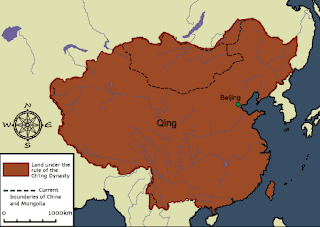
I. European “colonies”--because Europe came to dominate much of Africa and Asia in the 19th and 20th centuries, it has been assumed that this was the case in the 16th, 17th, and 18th centuries, as well. Europeans ran small trading outposts on these continents, however, and remained there at the pleasure of their hosts.
A. Asia and the Columbian Exchange--the so-called “Columbian Exchange” proved to be a dietary revolution for all of the world.1. The cultivation of maize--spread to the rest of the world, increasing the amount of calories available for consumption, which also spurred a boom in population in the rest of the world outside of the Americas (which, due to the exposure to European microbes, saw a precipitous drop in native population).
2. The cultivation of the potato--also spread to much of the world--especially that part of the world that proved too cold for maize, and was a favorite of peasants because it could be stored out of sight of landlords (left in the ground, it would remain good for many months during colder weather).
B. Asian Powers1. Ottoman Turks--after conquering Constantinople in 1453, the Turks went onto take Cairo in 1517, Hungary in 1526, Algiers in 1528, and besieged Vienna in 1529 and again in 1683.
2. Persian Safavid Empire--established the Shi’a sect of Islam as the state religion, and led a 250-year flowering of Persian culture, particularly poetry, which a number of shah’s wrote.
3. Japan--although Japanese culture appropriated many ideas from China (their system of writing, slightly modified religious practices and beliefs), along with a social organization reminiscent of European feudalism (nobles fighting each other over land with hired hands--the samuri--with guns and swords)
4. Rise of Russia--from the Duchy of Muscovy began the expansion outward which created the modern Russia.
II. China’s Renaissance

A. Zheng He and the Great Fleet
B. Recovery of Agriculture1. New machines of cultivation
2. Irrigation improvements
3. Industrialization of agriculture--produced crops like cotton, dyes (indigo, etc), vegetable oils, and tobacco (another “benefit” of the Columbian Exchange)
C. Industrial technology1. Printing press--using wooden blocks, but printing in three and four colors.a) Led to widespread literacy, dissemination of information, the development of popular literature (in vernacular Chinese, rather than strictly in official Mandarin)
b) China experienced its “renaissance” at the same time as Europe, spurred by the reinvigoration of agriculture (producing a surplus), which freed up a number of other people to practice other trades2. Silk looms
3. Cotton mills
4. Paper mills
5. Ceramics--all of these industries produced goods that were traded around the world from the 16th and 17th centuries, and spurred the development of a number of domestic industries.
D. Inequality of wealth distribution--the beneficiaries of the surplus were largely landlords and mill owners; farmers and workers received little recompense or reward for their labor.1. Climatic changes--do play a significant part in tipping the balance fro surplus to subsistence.
2. Inequality--because of the great wealth disparity, however, minor declines in the amount of food harvested meant that those on the bottom of the economic ladder suffered the most.
3. Restriction of trade--while Menzies focuses upon the opportunities lost for the Chinese to get credit for the “discovery” of the Americas due to the jealousies of Confucion clerks, trade was restricted in order to limit the growing influence of merchants--and the threat this posed to the control the emperor maintained.a) unauthorized trade was labeled “piracy.”
b) Trade was not completely shut off, of course; the Portuguese would arrive in Macau in 1535--but trade with outsiders was restricted to these kinds of encampments.4. Floods, famine--the population in China had grown from around 70 million in the 14th century to an estimated 170 million by 1650. After a series of devastating floods, followed by periods of drought, the surplus of food was gone.a) Not all areas of China were affected by famine and floods, but no effort was made by the government to move food from areas of plenty to areas of want.
b) This led to thirty years of peasant riots in various places around the country.5. Crisis made worse by government structurea) 45 princes of “first rank” received incomes equal to 600 tons of grain a year (1,200,000 pounds)
b) Burden of making good on these payments fell largely on peasants; for example half of the tax revenues from to provinces (Shansi and Honan) went into paying the allowance for their princes.
E. Political collapse1. 1644--last Ming emperor committed suicide, peasant who led uprising declared himself emperor in his stead.
2. Manchu invaders from Manchuria invade and capture Beijing
3. Merchants and artisans--the Chinese “bourgoisie” of the period were not able to step up into this vacuum of leadership because their growth had been systematically stunted.
III. Mogul India
A. Islamic rulers1. 13th Century--a succession of Islamic rulers had overrun northern India. They ruled through a system that made local officials--known as zamindars--responsible for collecting taxes from peasants on the land the zamindars owned--but the zamindars had to turn over a portion to the Islamic rulers.a) most of the surplus extracted never made it back to the peasants, but went instead into expenses of the imperial court, the state bureaucracy, and maintaining the military; the state, therefore, was the chief exploiter.
2. Indian cities--among the largest and most opulent in the world in the 1500s and 1600s, but little of the wealth created and displayed in these cities made its way back to the countryside.
3. Proto-industriesa) Textiles--exported to Europe4. Peasant discontent--found expression in the rise of new religious sects, like the Sikhs, but shied away from using the language of outright rebellion. Religions initially taught concepts of humility and resignation, rather than militancy and physical struggle.a) This outlook changed as conditions worsened; eventually, Sikhs and Marathas combined to defeat the Moguls in the 18th century.









No comments:
Post a Comment